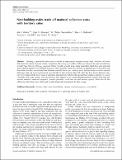Files in this item
Nest-building males trade off material collection costs with territory value
Item metadata
| dc.contributor.author | Bailey, Ida E. | |
| dc.contributor.author | Morgan, Kate V. | |
| dc.contributor.author | Oschadleus, H. Dieter | |
| dc.contributor.author | DeRuiter, Stacy L. | |
| dc.contributor.author | Meddle, Simone L. | |
| dc.contributor.author | Healy, Susan D. | |
| dc.date.accessioned | 2016-07-19T13:30:08Z | |
| dc.date.available | 2016-07-19T13:30:08Z | |
| dc.date.issued | 2016-01-25 | |
| dc.identifier | 244399456 | |
| dc.identifier | 826766b8-9dd0-43b9-a2bd-f107976d1d82 | |
| dc.identifier | 84957633326 | |
| dc.identifier | 000370058800001 | |
| dc.identifier.citation | Bailey , I E , Morgan , K V , Oschadleus , H D , DeRuiter , S L , Meddle , S L & Healy , S D 2016 , ' Nest-building males trade off material collection costs with territory value ' , Emu , vol. 116 , no. 1 , pp. 1-8 . https://doi.org/10.1071/MU15022 | en |
| dc.identifier.issn | 0158-4197 | |
| dc.identifier.other | ORCID: /0000-0002-8059-4480/work/60631258 | |
| dc.identifier.uri | https://hdl.handle.net/10023/9164 | |
| dc.description | This work was supported by the BBSRC (BB/I019502/1 to SDH and SLM) and Roslin Institute Strategic Grant funding from the BBSRC (SLM). | en |
| dc.description.abstract | Building a structurally robust nest is crucial for reproductive success in many birds. However, we know little about the criteria birds use to select material or where they go to collect it. Here we observed the material collection of male Cape Weavers (Ploceus capensis). Males typically selected long, strong material to build their nests and each male collected material from different locations. Males that built more nests nested in a different area of the colony and flew further to collect nest material than did males that built fewer nests. As these males that flew further to collect material had longer tails and wings and attracted more females to their territories than did males that flew shorter distances, they may have traded off the travel costs of collecting nest materials with benefits gained from holding a territory in a more 'desirable' part of the colony. Nest construction, then, appears to be a multi-dimensional task whereby birds take into account material's structural properties, material proximity to the nest site and territory quality. Males that do this effectively both attract more mates and provide structurally sound nests for their young. | |
| dc.format.extent | 8 | |
| dc.format.extent | 297296 | |
| dc.language.iso | eng | |
| dc.relation.ispartof | Emu | en |
| dc.subject | Distance | en |
| dc.subject | Flight costs | en |
| dc.subject | Individuality | en |
| dc.subject | Location | en |
| dc.subject | Material properties | en |
| dc.subject | Weaverbirds | en |
| dc.subject | QH301 Biology | en |
| dc.subject | Animal Science and Zoology | en |
| dc.subject | Ecology, Evolution, Behavior and Systematics | en |
| dc.subject | Nature and Landscape Conservation | en |
| dc.subject | NDAS | en |
| dc.subject.lcc | QH301 | en |
| dc.title | Nest-building males trade off material collection costs with territory value | en |
| dc.type | Journal article | en |
| dc.contributor.sponsor | BBSRC | en |
| dc.contributor.institution | University of St Andrews. School of Biology | en |
| dc.contributor.institution | University of St Andrews. School of Mathematics and Statistics | en |
| dc.contributor.institution | University of St Andrews. Centre for Research into Ecological & Environmental Modelling | en |
| dc.contributor.institution | University of St Andrews. Institute of Behavioural and Neural Sciences | en |
| dc.contributor.institution | University of St Andrews. Centre for Social Learning & Cognitive Evolution | en |
| dc.contributor.institution | University of St Andrews. Centre for Biological Diversity | en |
| dc.identifier.doi | https://doi.org/10.1071/MU15022 | |
| dc.description.status | Peer reviewed | en |
| dc.identifier.url | http://www.scopus.com/inward/record.url?scp=84957633326&partnerID=8YFLogxK | en |
| dc.identifier.grantnumber | BB/I019502/1 | en |
This item appears in the following Collection(s)
Items in the St Andrews Research Repository are protected by copyright, with all rights reserved, unless otherwise indicated.

